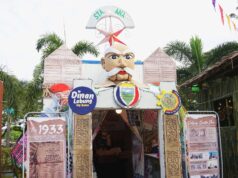SUBIC BAY FREEPORT – The Subic Bay Metropolitan Authority (SBMA) joined the global celebration of World Oceans Day on Wednesday by seeding an endangered species of giant clam at the Ilanin Bay marine sanctuary in this free port.
The SBMA Ecology Center, along with 12 volunteer divers from various dive shops in the Subic Bay area, “planted” 72 giant clams (tridacna gigas) species to help enhance marine biodiversity in Subic Bay.
The volunteer divers were from Boardwalk Dive Center, Johan’s Scuba Dive, Ocean Adventure, PNP Maritime Command, SBMA Harbor Patrol, SBMA Intelligence Office, and SBMA Ecology Center.
Ilanin Bay was chosen for seeding of giant clams after an examination by volunteer biologists showed the presence of giant clams in the area, which also passed the physical and biological criteria for a seeding bed, said Ecology Center manager Amethya Koval.
The visibility of the seeding area from the shore would also make it easy for authorities to guard it against illegal poachers, Koval added.
The giant clam “seeds”, which measured 15 centimeters in diameter, can actually grow up to 1.54 meters in diameter and weigh up to 258.55 kilos, biologists said.
The clam seeds were purchased from the Marine Science Institute of the University of the Philippines in Bolinao, Pangasinan with money raised from the “Takbo para sa Taklobo” fun run that was organized by the SBMA Ecology Center last year.
“We raised some P54,000 from registration fees in the fun run, and that’s what we used to buy giant clam seeds, as well as for other incidental expenses like food for volunteers during the seeding process,” Koval said.
“If the seeding project turns out to be a success, the Ecology Center will organize more ‘Takbo para sa Taklobo’ fun runs to help fast track our mission of saving these beautiful creatures from extinction,” she added.
Meanwhile, SBMA administrator Armand Arreza said the project is part of the agency’s vision of making the Subic Bay Freeport an eco-urban center that effectively blends industrial development with ecological tourism.
“Eco-tourism is one of our biggest industries here, and Subic Bay is among the dive sites that are frequented by tourists because of its historical shipwrecks and ecological biodiversity,” Arreza said.
“While we have these natural attractions as assets, we recognize the need to also help in protecting and propagating marine species like the endangered giant clams,” he added.




